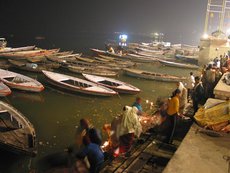Ganges River
|
|
Early_morning_on_the_Ganges.jpg
The River Ganges (Ganga in Indian languages) (Devanagiri गंगा) is a major river in northern India. It originates as the Bhagirathi from the Gangotri Glacier in the Uttaranchal Himalaya and joins the Alaknanda near Deoprayag to form the Ganga. Then on, the Ganga flows across the large plains of North India (called the Gangetic Plains) and empties into the Bay of Bengal after dividing up into many distributaries. One of them is the Hoogli River near Kolkata, another major distributary being the Padma River that enters Bangladesh.
The total length of the river is about 2,507km (1,558 mi). One of the densest human population belts on earth is built around the Ganges.
The region encompassing the delta near the Bay of Bengal coast is known as The Sundarbans (Beautiful Forests) – a region of thick mangrove forests, and one of the major habitats of the Royal Bengal tiger.
The Ganges Basin is incredibly fertile and, at present, about one in every 12 people in the world (8%) live in its catchment area. However, due to this incredible concentration of population, pollution and destruction of habitats is increasing at an alarming rate in the region.
The Yamuna River — a major river in its own right, and nearly as sacred — is a tributary of the Ganga, and their confluence is near what is the site of the traditional holy Hindu city of Prayag, now known as Allahabad.
Two species of dolphin can be found in the Ganges, the Ganges River Dolphin and the Irrawaddy Dolphin. The Ganges is also notable in that it contains a rare species of freshwater shark, Glyphis gangeticus about which little is known.
| Contents |
The Ganga in Hinduism

The Ganga is personified in Hinduism as a goddess: Ma (Mother) Ganga, mother of Karttikeya by Agni.
Several places sacred to Hindus lie along the banks of the river Ganga, including Haridwar and Varanasi. It is believed that taking a dip in the river will wash away one's sins, and that having one's ashes disposed of in the Ganga after death may improve one's next life or even allow Moksha to be attained sooner. Devout Hindus make pilgrimages to bathe in the Ganga and to meditate on its banks.
According to the mythological legend, Brahma collected the sweat of Vishnu's feet and created Ganga. Being touched by two members of the Trimurthi, Ganga became very holy.
Several years later, a king named Sagar magically acquired sixty thousand sons. One day, King Sagar performed a ritual of worship for the good of the Kingdom. One of the integral parts of the ritual was a horse, which was stolen by the jealous Indra. Sagar sent all his sons all over the Earth to search for the horse. They found it in the Underworld next to a penitent sage Kapila. Believing that the sage had stolen the horse, they hurled insults at him and caused his penance to be disturbed. The sage opened his eyes for the first time in several years, and looked at the sons of Sagar. With this glance, all sixty thousand were burnt to death.
Ganga_Mahabalipuram.jpg
The souls of the sons of Sagar wandered as ghosts since their final rites had not been performed. When Bhagiratha, one of the descendants of Sagar by a second wife, learnt of this fate, he vowed to bring Ganga down to Earth so that she could sweep away the ashes to heaven.
Bhagiratha prayed to Brahma that Ganga come down to Earth. Brahma agreed, and he ordered Ganga to come down to the Earth and then on to the Underworld so that the souls of Bhagiratha's ancestors would be able to go to Heaven. The vain Ganga felt that this was insulting and decided to sweep the whole Earth away as she fell from the Heavens. Alarmed, Bhagiratha prayed to Shiva that he break up Ganga's descent.
Ganga arrogantly fell on Shiva's head. But Shiva calmly trapped her in his hair and let her out in small streams. The touch of Shiva further sanctified Ganga. As Ganga travelled to the Underworld, she created a different stream to remain on Earth to help purify unfortunate souls there.
Because of Bhagiratha's efforts Ganga descended on to earth and hence the river is also known as Bhagirathi, and the term "Bhagirath prayatna" is used to describe valiant efforts or difficult achievements.
Another name that Ganga is known by is Jahnavi. Story has it that once Ganga came down to earth, on her way to Bhagiratha, her rushing waters created turbulence and destroyed the fields of a sage called Jahnu. He was angered by this and drank up all of Ganga's waters. Upon this, the Gods prayed to Jahnu to release Ganga so that she could proceed on her mission. Pleased with their prayers, Jahnu released Ganga (her waters) from his ears. Hence the name "Jahnavi" (daughter of Jahnu) for Ganga.
Pollution Of the Ganges
The pollution of the Ganges River is becoming increasingly worse as time goes on. Pollution that is found in the Ganges include cremated corpses, livestock carcasses, raw sewage, waste from factories, and the used water from peoples' daily lives. There have been many attempts to clean up the Ganges, but they have either failed or made the problem worse. India's government has already spent over $33 million to address the overwhelming sewage problem.
References
- Darian, Steven G.,The Ganges in Myth and History, The University Press of Hawaii, Honolulu (1978) [ISBN 0824805097]
- Newby, Eric, Slowly down the Ganges, Lonely Planet Publications (1998) [ISBN 0864426313]
Ganges is also the name of a commune in the Hérault département in France.
See also
ar:الغانج bg:Ганг cs:Ganga de:Ganges et:Ganges es:Ganges fr:Gange hi:गंगा he:גנגס it:Gange nl:Ganges ja:ガンジス川 pl:Ganges pt:Rio Ganges sa:गङ्गा sv:Ganges uk:Ґанґ zh:恒河
